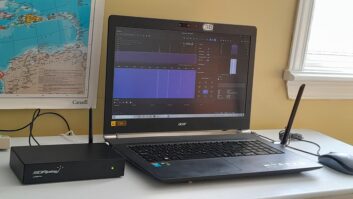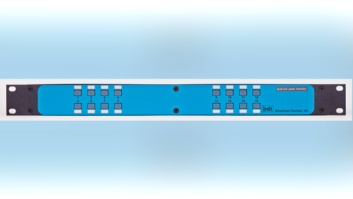Even in today’s digital, IT-intensive radio plant, there is still a need to design and build one-of-a-kind electronic circuits.
Simple devices such as digital tone generators and small distribution amps aren’t really profitable for companies to manufacture and sell. Other circuits may need to be created for requirements that are unique to your station. Control interfaces between an older analog console and an automation system come to mind. And sometimes it’s cheaper or just more fun to design and build your own equipment.
For More InfoProtoLab 4.0 $49.95 Contains a library of ready-made circuits and five virtual test instruments Global Specialties (800) 572-1028 www.globalspecialties.com
Visual Spice 6.0 $99; professional $249 Advanced 32-bit analog, digital, mixed signal simulator Island Logix Inc. (954) 981-6998 www.islandlogix.com
Electronics Workbench $2,000 – $4,000 A modular suite of products with software for schematic capture, simulation, PCB layout and autorouting and CAM preparation (800) 263-5552 www.interactiv.com
Sadly, the road between a sound schematic and a working circuit can have many detours and land mines. Lead capacitance and critical parts placement can be particularly troublesome in RF gear. Digital circuits can suffer from propagation delays, glitches, timing violations and bus conflicts. Getting a new circuit to work properly is usually the most tedious and time-consuming part of the process.
Fortunately, software is available to assist both with circuit design and PC board layout. Circuit simulation products range from simple packages costing around $49, to elaborate design suites costing up to $4,000, which can integrate with Computer-Aided Manufacturing equipment and work directly with PC board manufacturers.
On the grid
Much can be accomplished even with low-end products.
Using Global Specialties ProtoLab 4.0, for example, users insert components on a grid similar to a breadboard. Parts are selected from libraries of active and passive devices. Additionally, there is a library of pre-designed circuits, including MOSFET and transistor amplifiers, LC tuned circuits, power supplies, current mirrors and oscillators.
Once a circuit has been built on the virtual breadboard, users can adjust timing intervals, apply power and signal sources. It is then possible to test and debug the circuit by placing the probes from virtual test equipment at the desired nodes. ProtoLab includes a voltmeter, ammeter, ohmmeter, wattmeter and oscilloscope.
A basic circuit simulation program does have some limitations. Users are limited only to basic digital circuits in addition to analog. It is not possible to add additional libraries of electronic components. Finally, programs such as ProtoLab cannot turn the completed circuit into a PC board layout.
Global Specialties National Sales Manager Frank Menichello adds: “While there is a market for programs that design PC boards, there are still a lot of people who prefer to take a working circuit and build it using conventional breadboarding tools and test equipment.”
He said some of the limitations of ProtoLab, such as the ability to add component libraries, will be fixed in the next version of the product, due this spring.
SPICE-y
Mid-range products offer more possibilities. IslandLogix’s Visual Spice is a 32-bit analog, digital, mixed-mode simulator. SPICE – Simulation Program for Integrated Circuit Emphasis – is a general-purpose circuit simulation program for nonlinear DC, nonlinear transient and linear AC analysis. SPICE however, only allows simulation of analog devices.
Included in the software are a 64-channel real-time oscilloscope, logic analyzer and programmable signal generator. In addition to SPICE capability, Visual SPICE 6.0 provides XSPICE, which offers additional flexibility, as Nigel Smith, a software engineer for IslandLogix explains.
“With XSPICE, speed and accuracy is much faster, since devices are modelled at the C/C++ program level, rather than using macro models. XSPICE also allows plug-in devices to output text and graphics directly to the schematic, allowing results to be displayed during the simulation.”
Smith said that with XSPICE, an entire module can be modeled, including items such as modems, proprietary ICs, USB ports or wireless devices.
Very simulating
High-end products such as Electronics Workbench can take a circuit design all the way from idea to manufacturing, and have more advanced features, including interactive simulation.
Said Ian Suttie, vice president of sales and marketing, “It’s possible to make adjustments and changes to the circuit while the simulation is running, enabling real-time ‘what if’ scenarios to be developed. The simulation is embedded in the schematic capture part of the program, so simulations can be run early in the design process.”
More advanced virtual test instruments are available. Through a partnership with Tektronix, Electronics Workbench has developed software models of Tek oscilloscopes, which look and function like the real thing.
Both advanced analog and digital circuitry can be included on designs using high-end software. Lower-end programs cannot always handle both analog and digital in one circuit, or may require the user to purchase and add-on module for fully integrated design capability.
An add-on module for RF circuits can handle issues such as trace shielding, component spacing and lead dressing, which are critical in designing high-frequency circuits.
Once a circuit design has been finalized, another software module can handle the PC board layout.
“A nice feature of this software is that if you make circuit changes to tweak the PC board, those changes are propagated back to the schematic diagram,” Suttie said.
The software can check for maximum current flow in parts of the circuit, and define the minimum trace width accordingly. Finally, Electronics Workbench can design the parts placement layout to be silkscreened on top of the completed PC board.
Also included is an entry-level CAD package to do faceplate and chassis design. Alternately, the data can be exported into a more robust program such as AutoCAD.
The market for circuit simulation software seems to be expanding. “A recent survey showed that about 60 percent of engineers now use some form of design software for circuits,” Suttie said. “That is up significantly from just five years ago.”
Closer look
Even though circuit simulation software use is on an upswing, it is does not appear to be seen on many chief engineers’ computer desktops. Frank Foti, president of Omnia Systems, thinks it deserves a closer look by broadcasters.
“Engineers at the station level are too busy with other tasks to spend much time in the shop breadboarding circuits,” he said. “Ironically, some of the long-range projects on their to-do list involve designing and building circuits, which could be completed quickly if they had this type of software. Not only could they build the circuits, they could probably take the extra steps to get them totally right in less time than it would take to get the basic circuit going with conventional tools.”
Foti said that at the systems level, engineers might benefit from XSPICE by modelling devices such as modems, RDS coders and remote interfaces.
Designing and building equipment from scratch has been a part of the broadcast engineering tradition since equipment was actually built on wooden breadboards. Circuit simulation software takes some of the time and tedium out of the process, and may make it possible for engineers to get to some of those construction projects which have been on their to-do list for so long.







